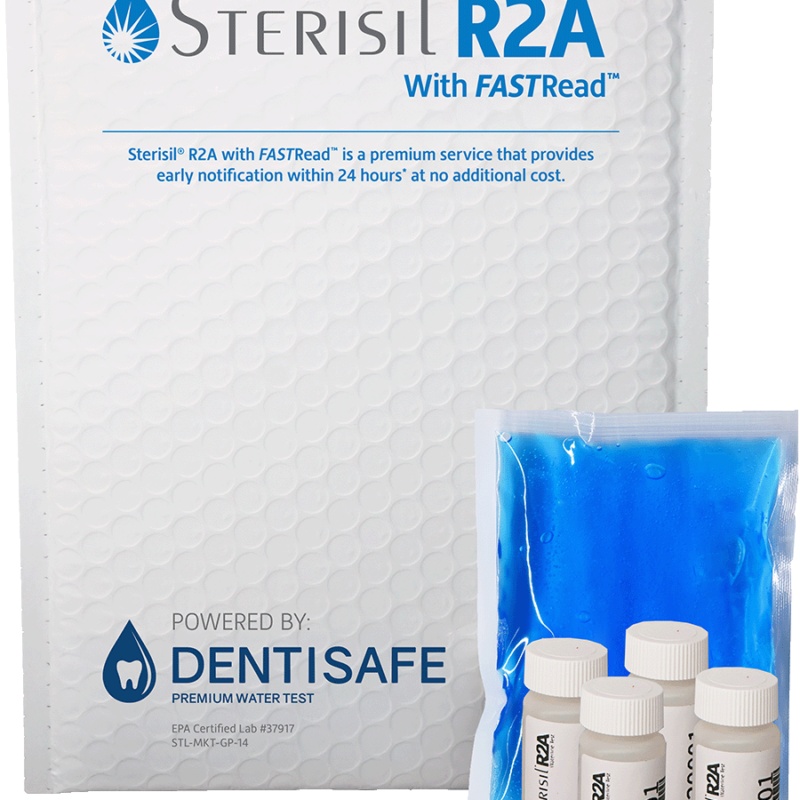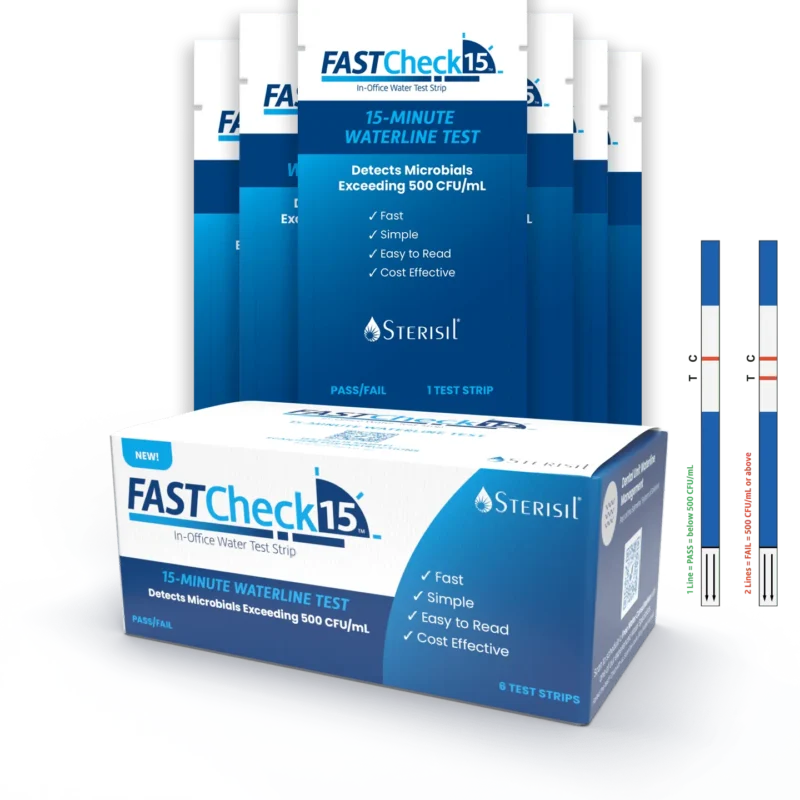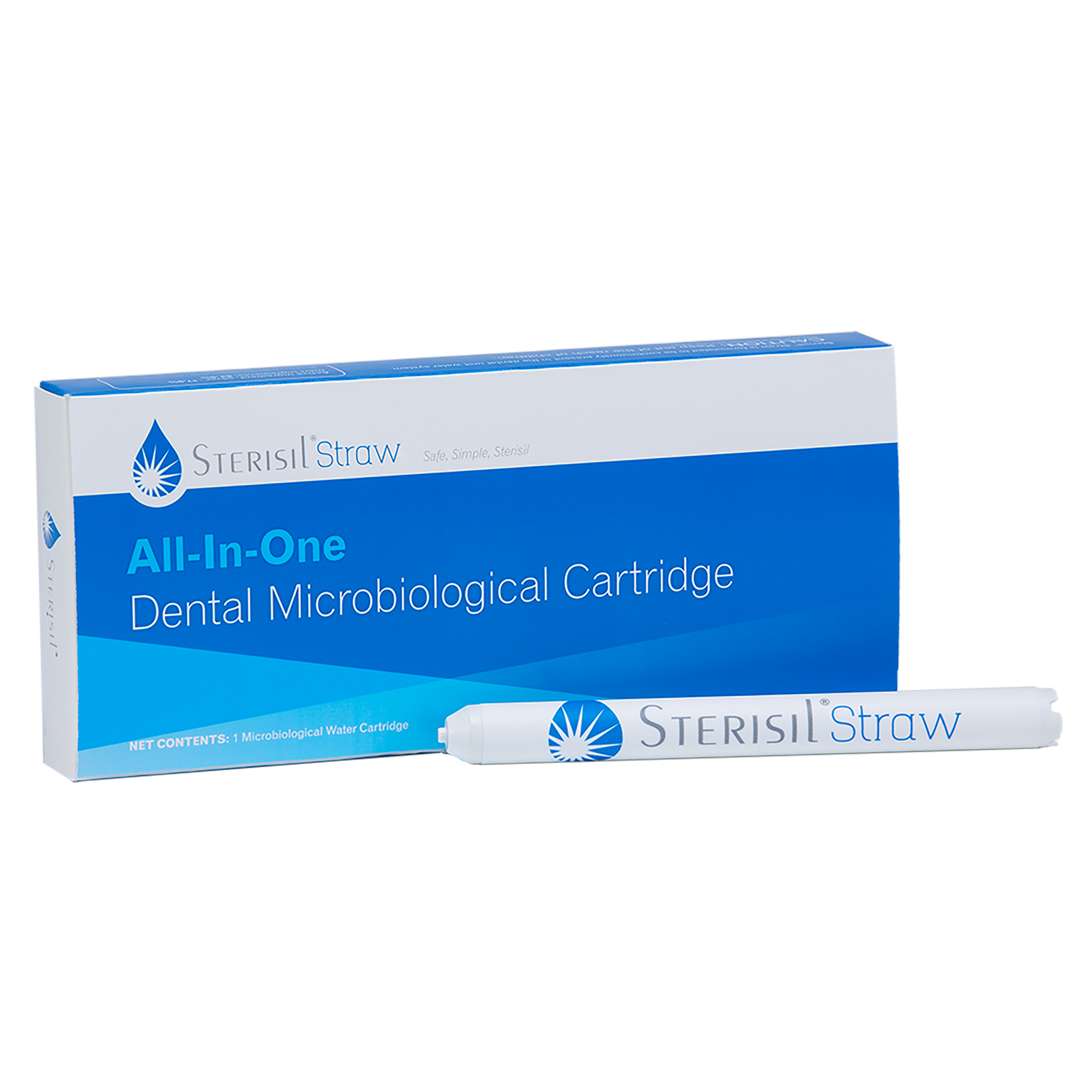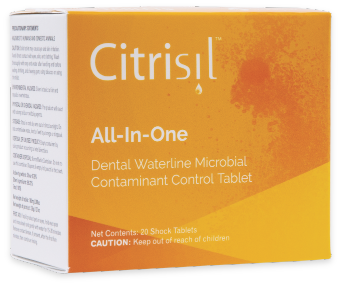
FASTCheck15™ Frequently Asked Questions (FAQ)
Here are some common questions dental professionals may have about FASTCheck15™.

Frequently Asked Questions
1Q: Do I fill the vial with our water sample to the line marker that appears on the vial?
No!! Only place 5 drops of sample water, using the pipette provided, into the test vial. Placing more than 5 drops will dilute the sample and lead to an inaccurate result. Only place 5 drops into the vial.
Overfilling the vial will likely result in no lines appearing on the test strip, which indicates that the test did not function properly. Always refer to the instructions for use (IFU).
2Q: What’s a “pooled sample?”
Pooling is a method of combining water samples from multiple handpieces/lines in the same chair in a single sample for testing. “Pooling” samples is a reasonable method if one sample represents a single dental unit.
(Do not combine samples from different units.) If a test fails, it is important to shock the entire dental unit. When shocking and maintaining the unit, all lines must be treated.
3Q: It’s been 15 minutes and I don’t see anything. Why?
If you do not see the control line appear after 15-20min, the test did not work for some reason. Review the test instructions for use. Mistakes happen. Potential reasons for the test not working include:
Placing more than 5 drops of water dispensed from the pipette provided. This results in an over-diluted sample.
Not swirling the water sample in the vial. This is essential to ensure the reagent in the vial is sufficiently mixed into your water sample.
Not conducting the 5 and 10 minute steps at the prescribed time. It’s very important to conduct the steps at the times indicated in the instructions. Missing the timing by a couple of minutes or more can prevent an accurate result. Always set a timer!
Be sure you’re reading the results under sufficient lighting. If you are repeatedly getting inconclusive results, contact Sterisil / Solmetex customer support.
4Q: Do we need to use a neutralizer?
Unlike some HPC “paddle” tests, FASTCheck15™ does not require a neutralizer. It uses a completely different technology that provides an accurate assessment in real-time without waiting for incubation.
5Q: How often should we test our waterlines?
Sterisil recommends testing monthly using the FASTCheck15™ in office waterline test. OSAP recommends monthly testing until two successive passing results are obtained, then at least quarterly. These guidelines were developed before new technologies such as FASTCheck15™ were available.
FASTCheck15™ has changed the game by providing dramatically faster results that enable immediate action that’s never been possible before. Sterisil recommends testing monthly using the FASTCheck15™ in office waterline test. And because it is easy and more affordable than other tests, it provides a way to be aware, be proactive, and address problems before they get worse. Bacteria duplicates every 4-20 minutes and can exceed the <500 CFU/ml EPA drinking water standard within hours in untreated lines.
Monthly testing is now practical and affordable. Testing is knowing.
6Q: What if I get a failed test?
Per established OSAP Guidelines, a dental unit that fails a waterline test should be shocked and retested (with the same test method). If you fail again, confirm you are conducting the sampling and testing according to the instructions for use. OSAP Guidelines call for shocking / cleaning the lines again before treating patients, and testing until a passing test is achieved.
If two successive testing failures occur, Sterisil recommends conducting a mail-in R2A lab testing to obtain a more specific CFU count and for assessment of water chemistry for troubleshooting the potential source of the repeated failures.
If you need more help consult with your Sterisil Water Safety Specialist or contact Sterisil customer support. Visit the Water Testing page at our customer portal My Solutions Center. There you can log your test results where they can be archived, analyzed, and used to support your ongoing waterline infection control efforts.
7Q: We can’t pass a test no matter what we do. Now what?
Are you certain that you’re following your product IFUs, for both treatment and testing? IFU’s vary widely depending on the products being used. Shock/clean your waterlines thoroughly. Most cases of repeated failures are due to biofilm accumulation that if significant, may not be successfully removed by simply shocking the lines.
If you’re failing multiple mail-in tests you probably have a biofilm problem that will require more intensive cleaning with an approved dental unit waterline cleaner. We do not recommend bleach as it is known to be corrosive to metal parts and over time will damage handpieces, valves and the many metal parts within the dental unit, and downstream it can do the same damage to your vacuum. It is known to interfere with proper operation of your Amalgam Separator and will void your product warranty.
8Q: Why do you recommend waiting for 5 days to re-test waterlines after a test failure (and shock)?
The cause of test failure is bacteria in effluent water that is released from biofilm that has attached to the surface of the waterlines and handpieces. This is why experts will tell you: “your water isn’t the problem, it’s your waterlines”. Shocking kills the floating bacteria in the water, however it may not completely remove biofilm. Biofilm is very difficult to completely remove, and after shocking it gradually returns to releasing bacteria into your water.
Testing immediately after shocking may not tell you the health of your waterlines, it will tell you that you removed the floating bacteria, which could repopulate from any residual biofilm within a few days. That’s why leading experts recommend waiting several days or ideally a week to retest following shocking your lines. By doing so, and adopting a monthly Test + Shock regimen, you have a much better chance of being successful in managing the health of your waterlines.
9Q: How does FASTCheck15™ and the Sterisil® SafeWater Solution help improve overall results in water safety management?
The complexity of water safety management works against its inherent goal. Per OSAP: “Successful management of water quality is subject to many variables including dental unit design, efficacy and compatibility of germicidal or cleaning products, input water quality and staff compliance. This inherent complexity can lead to treatment failure even with products that have shown excellent results in laboratory or controlled clinical settings.” The Sterisil line of products is designed to work simply, and work together for this very reason. Sterisil® = Simple Success.
10Q: Does FASTCheck15™ detect fungi or viruses?
FASTCheck15™ does not detect fungi or viruses because bacteria are the dominant challenge to maintaining safe, clean water and dental unit waterlines. Bacteria forms biofilm which becomes the persistent problem that needs to be treated and removed with shocking and line cleaning.
FASTCheck15™ is designed to provide the quickest, most accurate way to know the microbial burden within your waterlines so you can take quick, decisive action.
11Q: Is testing waterlines for specific organisms necessary?
Per the CDC, “because methods used to treat dental water systems target the entire biofilm, no rationale exists for routine testing for such specific organisms as Legionella or Pseudomonas, except when investigating a suspected waterborne disease outbreak.”
12Q: FASTCheck15™ doesn’t indicate microbial levels below 500CFU/mL.
We want to know before we’re over the limit. Being proactive in monitoring your microbial levels is absolutely the right way to approach waterline management.
FASTCheck™ is a 15-minute in-office water bacteria test designed to provide pass/fail indication to the EPA standard of 500CFU/mL. By being proactive with frequent regular testing, you can establish a record of monthly passed tests or act immediately when you fail a test.
By adopting a monthly Test + Shock regimen, you limit biofilm formation and have control before your CFU count exceeds 500. If persistent failures occur and you want an exact bacterial count, we recommend using our Sterisil R2A mail-in lab test. This combination will enable you to have information that’s fast and thorough, with a protocol that is easy and affordable.
13Q: Is an in-office test accurate enough?
When conducted properly, in-office water bacteria tests like FASTCheck15™ remove the risk of bacteria growing to harmful levels in in between water sampling and results. If a pattern of failures persists, a mail-in lab test can be used to provide greater detail on microbial levels, and water chemistry, to inform the next course of action. If you’re still having trouble contact Solmetex customer support. We’re here to help.
14Q: How does FASTCheck15™ compare to Flow Cytometry tests?
Both tests detect and measure the presence and level of bacteria concentration. Flow cytometry uses DNA staining. FASTCheck15TM detects cell surface proteins using a chemical reagent that binds to the proteins and rises on the test strip to a level based on bacteria concentration, which is the same method as a Covid test. FASTCheck15TM is different because it is easier, faster and more affordable. It enables immediate action if you fail a test and fits more easily into your protocol and your busy office workflow.
15Q: How does FASTCheck15™ compare to R2A tests?
Every test has limitations. Incubation test methods using Heterotrophic Plate Count (HPC) such as paddles and R2A are what we’ve had available for decades. Their drawbacks include: 1) delayed results while waiting for incubation, 2) potential error due to multiple human steps required in sample collection and transportation, 3) for R2A, careful packing and timely shipment is required; shipping delays can destroy samples, and 4) the incubation process grows all microbes including microbes that are encouraged to grow but weren’t pathogenic at time of sample collection. FASTCheck15™ resolves all of these issues with a simple, easy to perform test that provides a clear, definitive pass fail result, without any other handling required, and measures the level of microbes in your water at the time you test, not days or a week later.
16Q: How does FASTCheck15™ compare to a PCR test, like those used during the COVID-19 pandemic?
If you look back at the pandemic, we had two basic types of tests. In-home antigen tests, and lab PCR tests. FASTCheck15TM works similarly to the in-home tests in that it detects cell material from the microbe (in this case bacteria, as opposed to the Covid virus), and the result is revealed on a device like a test strip. PCR is different. That method detects DNA of the specific microbes. For DUWL testing, there are too many different strains to make it practical to detect DNA of all of them.
17Q: Other in-office test methods provide an indication of microbial concentration at levels below 500CFU/mL. Shouldn’t we know before we reach a dangerous level of bacteria?
The established safety standard by EPA and CDC is a maximum of 500 CFU/mL. FC15 provides an accurate measurement precisely to that standard. If you fail a test, or want to get more detailed CFU counts below 500 CFU/mL, an R2A lab test provides a more specific CFU count, along with water chemistry information that can help in troubleshooting potential causes for failed maintenance. R2A is more costly than other methods, so we recommend doing that quarterly or when you’re having difficulty passing tests and don’t know why. FASTCheck15™ lets you ensure you’re on track in between lab tests, with an easy and affordable test that gives you results right away, so you can act in real-time, not days or a week later. The Sterisil® SafeWater Test + Shock Protocol is easy, reliable, and puts you in control, so you can stay ahead of biofilm and worry less about specific CFU counts. Counting dots or reading color charts may suggest more precision, but these tests aren’t precise, and can incur error in handling and/or shipping the samples. FASTCheck15TM gives you an accurate, reliable pass/fail result so you know with confidence if your water is safe, or if you need to take corrective action.
Being proactive in monitoring your microbial levels is absolutely the right way to approach waterline management. FASTCheck™ is a 15-minute in-office water bacteria test designed to provide pass/fail indication to the EPA standard of 500CFU/mL. By being proactive with regular testing and shocking, and with an effective maintenance product, you can establish a record of monthly passed tests, or act immediately when you fail a test. By adopting the recommended Monthly Test + Shock protocol, you can reduce further biofilm formation and have control before your CFU count exceeds 500. If persistent failures occur, we recommend using our Sterisil R2A mail-in lab test which provides more detailed bacteria count AND water chemistry information that can be very valuable in diagnosing why you’re failing tests repeatedly. The Sterisil SafeWater Protocol includes a quarterly R2A testing for precisely this reason. The combination of fast in-office testing and more detailed lab testing will give you the best of both worlds, with a protocol that is easy and affordable.
18Q: How often should we test our waterlines?
Sterisil recommends testing monthly using the FASTCheck15™ in office waterline test. OSAP Guidelines call for monthly testing until two successive passing results are obtained, then at least quarterly. These guidelines were developed before new technologies such as FASTCheck15™ were available. FASTCheck15™ has changed the game by providing dramatically faster results that enable immediate action that’s never been possible before. Sterisil recommends testing monthly using the FASTCheck15™ in office waterline test. And because it is easy and more affordable than other tests, it provides a way to be aware, be proactive, and address problems before they get worse. Bacteria duplicates every 4-20 minutes and can exceed the <500 CFU/ml EPA drinking water standard within hours in untreated lines. Monthly testing is now practical and affordable. Testing is knowing.
19Q: Is recommending monthly testing with FASTCheck15TM just a way to sell more tests?
Actually, OSAP/ADS recommends frequent waterline testing for multiple reasons. OSAP/ADS Guidelines: “In-office test kits used on a more frequent basis may help ensure staff compliance with biofilm mitigation protocols and provide early warning of problems with biofilm control.”
20Q: Why is it necessary to shock monthly?
Shocking lines alone does not fully remove biofilm. Biofilm is insidious, invisible and very hard to totally eliminate. Biofilm can start even before your chair arrives at your office, due to pre-sale testing of chairs that can leave residual water in the chair. Testing frequently allows you to check for indications of biofilm build-up. The Sterisil® SafeWater Test + Shock protocol supports this, and when used with the 10 CFU Sterisil® straw, they work together to keep your practice safe.
21Q: Why do you recommend waiting for 5 days to re-test waterlines after a test failure (and shock)?
The cause of test failure is bacteria in effluent water that is released from biofilm that has attached to the surface of the waterlines and handpieces. This is why experts will tell you: “your water isn’t the problem, it’s your waterlines”. Shocking kills the floating bacteria in the water, however it may not completely remove biofilm. Biofilm is very difficult to completely remove, and after shocking it gradually returns to releasing bacteria into your water. Testing immediately after shocking may not tell you the health of your waterlines, it will tell you that you removed the floating bacteria, which could repopulate from any residual biofilm within a few days. That’s why leading experts recommend waiting several days or ideally a week to retest following shocking your lines. By doing so, and adopting a monthly Test + Shock regimen, you have a much better chance of being successful in managing the health of your waterlines.







